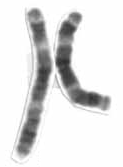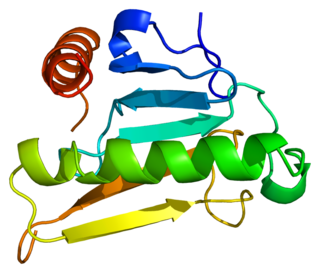An allele is a variant form of a given gene. Sometimes, the presence of different alleles of the same gene can result in different observable phenotypic traits, such as different pigmentation. A notable example of this trait of color variation is Gregor Mendel's discovery that the white and purple flower colors in pea plants were the result of "pure line" traits which could be used as a control for future experiments. However, most genetic variations result in little or no observable variation.

Fragile X syndrome (FXS) is a genetic disorder. Symptoms often include mild to moderate intellectual disability. The average IQ in males is under 55. Physical features may include a long and narrow face, large ears, flexible fingers, and large testicles. About a third of those affected have features of autism such as problems with social interactions and delayed speech. Hyperactivity is common and seizures occur in about 10%. Males are usually more affected than females.

A chromosomal fragile site is a specific heritable point on a chromosome that tends to form a gap or constriction and may tend to break when the cell is exposed to partial replication stress. Based on their frequency, fragile sites are classified as "common" or "rare". To date, more than 120 fragile sites have been identified in the human genome.

Chromosome 1 is the designation for the largest human chromosome. Humans have two copies of chromosome 1, as they do with all of the autosomes, which are the non-sex chromosomes. Chromosome 1 spans about 249 million nucleotide base pairs, which are the basic units of information for DNA. It represents about 8% of the total DNA in human cells.

Chromosome 3 is one of the 23 pairs of chromosomes in humans. People normally have two copies of this chromosome. Chromosome 3 spans almost 200 million base pairs and represents about 6.5 percent of the total DNA in cells.

Chromosome 10 is one of the 23 pairs of chromosomes in humans. People normally have two copies of this chromosome. Chromosome 10 spans about 133 million base pairs and represents between 4 and 4.5 percent of the total DNA in cells.

Collagen, type I, alpha 1, also known as alpha-1 type I collagen, is a protein that in humans is encoded by the COL1A1 gene. COL1A1 encodes the major component of type I collagen, the fibrillar collagen found in most connective tissues, including cartilage.

Aphidicolin is a tetracyclic diterpene antibiotic isolated from the fungus, Cephalosporum aphidicola with antiviral and antimitotic properties. Aphidicolin is a reversible inhibitor of eukaryotic nuclear DNA replication. It blocks the cell cycle at early S phase. It is a specific inhibitor of DNA polymerase A,D in eukaryotic cells and in some viruses and an apoptosis inducer in HeLa cells. Natural aphidicolin is a secondary metabolite of the fungus Nigrospora oryzae.

Bis(5'-adenosyl)-triphosphatase also known as fragile histidine triad protein (FHIT) is an enzyme that in humans is encoded by the FHIT gene.

Nuclear respiratory factor 1, also known as Nrf1, Nrf-1, NRF1 and NRF-1, encodes a protein that homodimerizes and functions as a transcription factor which activates the expression of some key metabolic genes regulating cellular growth and nuclear genes required for respiration, heme biosynthesis, and mitochondrial DNA transcription and replication. The protein has also been associated with the regulation of neurite outgrowth. Alternate transcriptional splice variants, which encode the same protein, have been characterized. Additional variants encoding different protein isoforms have been described but they have not been fully characterized. Confusion has occurred in bibliographic databases due to the shared symbol of NRF1 for this gene and for "nuclear factor -like 1" which has an official symbol of NFE2L1.

WW domain-containing oxidoreductase is an enzyme that in humans is encoded by the WWOX gene.

Fos-related antigen 1 (FRA1) is a protein that in humans is encoded by the FOSL1 gene.

Plakophilin-1 is a protein that in humans is encoded by the PKP1 gene.

Fos-related antigen 2 (FRA2) is a protein that in humans is encoded by the FOSL2 gene.

Homeobox protein Hox-D12 is a protein that in humans is encoded by the HOXD12 gene.

Caveolin-2 is a protein that in humans is encoded by the CAV2 gene.

FRA10AC1 is a protein that in humans is encoded by the FRA10AC1 gene.
Fragile site, 5-azacytidine type, common, fra(1)(q12) is a protein that in humans is encoded by the FRA1J gene.
Fragile site, folic acid type, rare, fra(2)(q13) is a protein that in humans is encoded by the FRA2B gene.
FRAXD or FRAXD gene is a gene symbol for fragile site, aphidicolin type, common, fra(X)(q27.2) D. The locus of the gene is located on fragile site of the q arm of chromosome X at position 27.2. It is used for gene testing in Homo sapiens.















